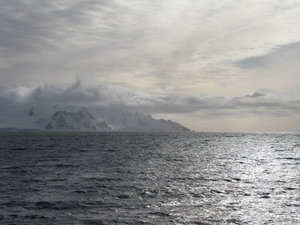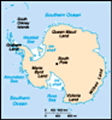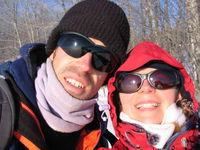Advertisement
Published: February 19th 2014

 Sunrise Sparkle
Sunrise Sparkle
The power of Antarctica can only be captured by one´s heart. A photo is a mere glimpse of what that would look like, but not felt.Finding the right words to describe what I have seen and experienced in the Antarctic will be difficult with our limited spoken language from our left brain. Perhaps, the best way would be to beam over to you, a vision from my heart what it really means and feels like, to be with the Albatross as its gargantuous wings sail over the waves of the Drake Passage, what it means to see my first mountain adorned by glaciers, feeding their ice tongues into the sea, what it means to be in a place of such extreme, rugged, prestine, natural and untouched beauty.
As soon as the first mountain met my gaze, as the ship moved closer and closer to our first destination of exploration, my spirit said, ¨You have arrived now. It is okay to open your heart to it¨. And it felt like a mountain had moved within my heart. Like the Earth moved inside me. Like an earthquake shifted my focus from my life before this moment, to this one moment of awe. The power of this place cannot be really written about, but only felt. So, again, I must reiterate, there are no words that could possibly

 Chinstrap Penguins
Chinstrap Penguins
Half Moon Island, in the South Shetland Islandscome close, but I will give it my best shot...
The photos I will post will be indeed beautiful and I do hope you enjoy them. In addition, they will serve as a trigger for my own heart-felt visions of enormity and scarcity of this very special place...
I may just attempt to summarize my entire 10 days into this one blog entry. The photos will be plentiful so they will spill onto a few blogs, I reckon. But they will be full of mini stories and comments...
The Drake Passage This wide open expansive part of the Southern Ocean is legendary. One of the roughest parts of the planet to traverse in a ship. As we wobbled across it in the Sea Spirit (with swells upto 8 metres high at times), with our beautiful meals and our warm comfy beds, I could not help but realize that the first explorers of Antarctica crossed the Drake in sailing ships much smaller, and it took them weeks. Their journeys often ended up with tragic stories of malnutrition and deaths by the time they reached land in the Antarctic. Some explorers became historical heros (such as the charismatic
public figures of Shakleton, Amundson and Scott). Some were not so well recognized for their discoveries as they should have been. (Yes, we had a wonderful historian on board, named Victoria who lectured about many of the explorers).
For us, it took only 2 days. We rocked back and forth in our beds, we grabbed onto rails in the corridors whilst scrambling to the lounge or dinning room, spilling the odd cup of tea, or watching an entire trayfull of clean glasses in the lounge slide off of the counter and go crash!
Granted half the passengers were in their rooms with sea sickness and sleeping off the side effects of their medicines (not including myself or Dave- we probably were both sailors in another life), they all were still happy to experience such a special place, once we arrived (and once we were in calmer waters).
The Landings The Quark Staff (with Dave included) and the Ship´s Crew had a very organized system to get us kitted up and ready for disembarking the ship onto zodiacs, so we could step onto some of the worlds´ most preserved wildlife areas and landscapes. Thanks to the Antarctic

 Juvenille Chinstrap Penguin
Juvenille Chinstrap Penguin
Molting its fuzzy down, it awaits its adult feathersTreaty which was only updated a few decades ago to protect the environment and ecosystems - the real thanks goes to the NGO´s who do most of the background work for proposals to the Treaty.
We had limited trails to use so that we would not disturb the ¨Penguin Highways¨ or step into a crevass or fall off of an ice shelf, to never be seen again. We had environmentally friendly detergent to clean our boots, so as to not contaminate any land mass that we walked on, with the dirt, seeds or guano (bird poop) from another land mass or island. We kept a healthy distance from all wildlife so that we did not scare or stress them. During the molting process for birds, they cannot feed until their feathers are fully replaced (which takes upto 6 weeks for some and their energy reserves are quite low). So we really took care around molting birds.
We watched penguins interact with each other in their roosts. We watched them emerge from the water from feeding in the sea, and walk back to their nests to feed their chicks. Sometimes this trek back to the nest was a long

 The late Phil the Krill
The late Phil the Krill
Penguins eating Krill will have a lovely red colour to their guano. Krill, normally a translucent colour, when stressed, create a red pigment. Hence the red poo. distance for their short little legs as they waddled their way up the Penguin Highways.
We learned about the snow algae. Pink and Green. Not to be confused with the pink poo or green poo from the pengies, depending on their diet at the time.
We learned about the landscape, the rocks, the moss, the lichen, and some vascular plant life (2 types of flowering plants) that can survive in Antarctica.
We learned about the marine life (and saw many whales! yay!). From the plankton to the krill to the fish, penguins, seals, and the whales.
We learned about the birds from our bird expert. We learned about the salt glands of the Albatross and Petrels to expel the sea salt from the sea creatures they fed on.
The highly qualified Quark Staff covered many subjects so that we could understand every aspect of the Antarctic. Everything from the history of exploration, the treaty, the politics, to the ecosystems and the wildlife. We were emersed in the lingo of the Antarctic for 10 wonderful days.
Enjoy the photos and the stories that go with them! There are more photos to come! Stay tuned!

 This is a late Penguin
This is a late Penguin
It seems by the other penguin carcasses, the feet are always left untouched. As cute as pengies are, they serve as a food source to other birds like the skuas and petrels.Theresa
“A ship in harbor is safe — but that is not what ships are built for.” — John A. Shedd
¨Time is the coin of your life. It is the only coin you have, and only you can determine how it will be spent. Be careful lest you let other people spend it for you.¨--Carl Sandburg
“There are only two ways to live your life. One is as though nothing is a miracle. The other is as though everything is a miracle.” --Albert Einstein
Advertisement
Tot: 0.393s; Tpl: 0.029s; cc: 24; qc: 171; dbt: 0.2218s; 1; m:domysql w:travelblog (10.17.0.13); sld: 1;
; mem: 1.4mb



























Jeremy Chiron
non-member comment
very special moment!
Pretty magical to be all the way down there! Thanks for sharing your experience! did the crew talk about the effects of global warming on Antarctica?